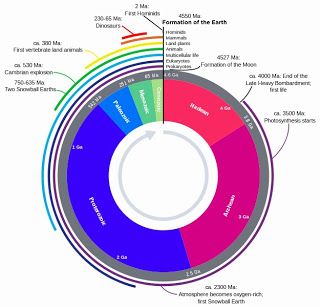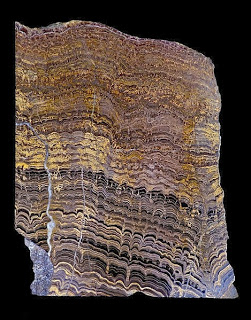What Was The Chemical Makeup Of The Atmosphere During The Cambrian Period

The Proterozoic is a geological eon representing the time just before the proliferation of circuitous life on World. The proper name Proterozoic comes from Greek and means "earlier life". The Proterozoic Eon extended from two,500 Ma to 542.0±1.0 Ma (million years ago), and is the virtually contempo function of the informally named "Precambrian" time. It is subdivided into three geologic eras (from oldest to youngest): the Paleoproterozoic, Mesoproterozoic, and Neoproterozoic.
The well-identified events of this eon were the transition to an oxygenated temper during the Mesoproterozoic; several glaciations, including the hypothesized Snowball Earth during the Cryogenian period in the belatedly Neoproterozoic; and the Ediacaran Menstruum (635 to 542 Ma) which is characterized past the evolution of abundant soft-bodied multicellular organisms.
The Proterozoic record
The geologic record of the Proterozoic is much improve than that for the preceding Archean. In contrast to the deep-h2o deposits of the Archean, the Proterozoic features many strata that were laid down in extensive shallow epicontinental seas; furthermore, many of these rocks are less metamorphosed than Archean-age ones, and plenty are unaltered. Written report of these rocks shows that the eon continued the massive continental accretion that had begun late in the Archean, as well as featured the first definitive supercontinent cycles and wholly modern orogenic activity
The first known glaciations occurred during the Proterozoic; i began soon later on the offset of the eon, while there were at least four during the Neoproterozoic, climaxing with the Snowball Earth of the Sturtian and Marinoan glaciations.
The accumulation of oxygen
One of the nearly important events of the Proterozoic was the accumulation of oxygen in the Earth's temper. Though oxygen is believed to have been released by photosynthesis as far back as Archean times, it could not build up to whatsoever significant caste until chemical sinks — unoxidized sulfur and iron — had been filled; until roughly 2.iii billion years ago, oxygen was probably only ane% to 2% of its electric current level. Banded fe formations, which provide most of the world'due south iron ore, were too a prominent chemic sink; their accumulation ceased after 1.nine billion years ago, either due to an increment in oxygen or a more thorough mixing of the oceanic h2o column.
Red beds, which are colored by hematite, indicate an increase in atmospheric oxygen afterwards 2 billion years agone; they are not found in older rocks. The oxygen buildup was probably due to two factors: a filling of the chemical sinks, and an increase in carbon burial, which sequestered organic compounds that would take otherwise been oxidized past the atmosphere.
Paleogeography and tectonics
Throughout the history of the Earth, there have been times when the continental mass came together to course a supercontinent, followed by the break-up of the supercontinent and new continents moving apart over again. This repetition of tectonic events is chosen a Wilson cycle. Information technology is at to the lowest degree clear that, nigh 1,000–830 Ma, most continental mass was united in the supercontinent Rodinia. Rodinia was not the first supercontinent; it formed at about ane.0 Ga past accession and collision of fragments produced by breakdown of the older supercontinent, called Nuna or Columbia, which was assembled past global-calibration 2.0–1.eight Ga collisional events. This means plate tectonic processes similar to today's must have been agile during the Proterozoic.
Later on the break-up of Rodinia most 800 Ma, it is possible the continents joined once more around 550 Ma. The hypothetical supercontinent is sometimes referred to as Pannotia or Vendia. The prove for it is a phase of continental collision known every bit the Pan-African orogeny, which joined the continental masses of current-day Africa, South America, Antarctica and Australia. It is extremely probable, however, that the aggregation of continental masses was not completed, since a continent chosen Laurentia (roughly equivalent to current-day N America) had already started breaking off around 610 Ma. It is at least certain that by the end of the Proterozoic eon, well-nigh of the continental mass lay united in a position around the s pole.
Life

The start advanced single-celled, eukaryotes and multi-cellular life, Francevillian Grouping Fossils, roughly
The blossoming of eukaryotes such as acritarchs did not preclude the expansion of cyanobacteria; in fact, stromatolites reached their greatest abundance and diverseness during the Proterozoic, peaking roughly 1200 million years agone.
coincides with the get-go of the accumulation of costless oxygen. This may take been due to an increment in the oxidized nitrates that eukaryotes employ, as opposed to cyanobacteria. Information technology was also during the Proterozoic that the first symbiotic relationships between mitochondria (for nearly all eukaryotes) and chloroplasts (for plants and some protists only) and their hosts evolved.
Classically, the boundary betwixt the Proterozoic and the Phanerozoic eons was fix at the base of the Cambrian menstruum when the first fossils of animals including trilobites and archeocyathids appeared. In the second half of the 20th century, a number of fossil forms have been found in Proterozoic rocks, just the upper purlieus of the Proterozoic has remained fixed at the base of the Cambrian, which is currently placed at 542 Ma.
Note : The above story is based on materials provided past Wikipedia
What Was The Chemical Makeup Of The Atmosphere During The Cambrian Period,
Source: https://www.geologypage.com/2013/10/proterozoic-eon.html
Posted by: fostersagoonger.blogspot.com


0 Response to "What Was The Chemical Makeup Of The Atmosphere During The Cambrian Period"
Post a Comment